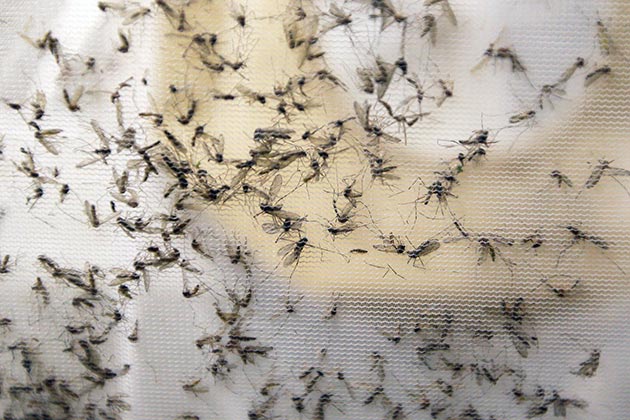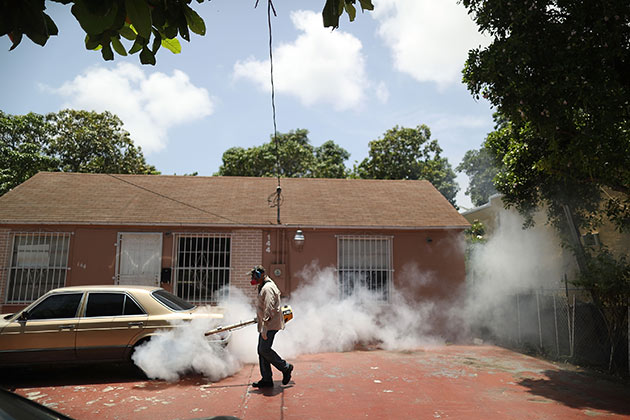Published On September 12, 2016
An infectious disease tends to get attention in this country only after it starts scaring people in the suburbs of the Northeast. Today, that fear has arrived in the blood-filled gut of the urban-dwelling, daytime-biting mosquito, Aedes aegypti. The insect can carry several viral diseases—yellow fever, dengue fever, chikungunya—that had traditionally been confined to countries in the tropics. It also can transmit Zika, a virus first identified in humans in 1952, now well known for its links to birth defects, particularly microcephaly.
The suburbs of New York City and Boston have yet to be invaded by Aedes aegypti, but the insect has lived for decades in Florida, Puerto Rico and along the Gulf Coast, and the mosquito’s estimated range has now expanded into half of the contiguous United States. Once, domestic cases of dengue, chikungunya—and more recently, Zika—involved people who contracted them abroad. But “homegrown” cases of dengue and chikungunya have started to appear, contracted from infected mosquitoes in Florida, Texas and other places. Zika has rapidly become endemic in Puerto Rico, and the first locally transmitted cases were reported in Miami in July. If Zika does become widespread in the United States, it will most likely take hold in an impoverished, warm and humid “hot zone” along the Gulf Coast and in southern Florida.
That region is already home to numerous other conditions known as neglected tropical diseases, or NTDs. This diverse group of insidious disorders may be transmitted by parasites, worms, mosquitoes and other bugs, notes Peter Hotez, president of the Sabin Vaccine Institute in Washington, D.C., and founder of the National School of Tropical Medicine at Baylor College of Medicine in Houston. They can cause debilitating sickness, deformities, developmental delays and cognitive deficits. NTDs are “the most important diseases you’ve never heard of,” Hotez has written.
They include cysticercosis, from a parasitic pork tapeworm that causes brain seizures and epilepsy, as well as toxocariasis, transmitted by a parasitic roundworm carried in the feces of infected dogs and cats that leads to asthma and neurological problems. (Though toxocariasis afflicts at least 2.8 million people in this country, there has been little research into how to prevent or treat it.) There’s also cutaneous leishmaniasis, a disfiguring skin infection transmitted by a tiny sand-fly parasite. Chagas disease, a parasitic infection, is a leading cause of heart failure and sudden death in Latin America—and can flare up among people now living in the United States. And lymphatic filariasis, caused by microscopic, thread-like worms that damage the body’s lymphatic drainage system, produces elephantiasis with grotesquely swollen limbs.

Normally thought of as plagues of the developing world—which is the focus for what little attention and research funding they receive—many of these diseases exist within U.S. borders, afflicting an estimated 12 million people, largely in impoverished pockets of Appalachia, the Mississippi Delta, other areas of the rural South, Native American tribal lands, U.S.-Mexico borderlands and disadvantaged urban enclaves. That pattern is repeated in other developed nations. Indeed, Hotez estimates that the world’s 20 wealthiest countries are home to about two thirds of NTD cases. Hotez has called them “forgotten diseases of forgotten people.” New efforts to recognize and address them there are long overdue.
Most neglected tropical diseases did originate in the tropics of Africa and Asia. But human migration long ago carried them around the world, and many came to the Americas during the Atlantic slave trade. Today, increased global travel and massive population upheavals driven by war, famine and climate change—which is making more and more of the world hospitable to the species of mosquitoes, bugs and worms that transmit these diseases—have accelerated their spread.
Yet it can be hard to generalize about NTDs, says Stephen Calderwood, chief of the division of infectious diseases at Massachusetts General Hospital, because they are such a disparate group of infections spread in so many ways. Some are chronic and don’t cause symptoms until long after infection. Some are caused by parasites with complex life cycles that involve several types of animals or other hosts. Others stem from viruses or parasites transmitted by vectors such as mosquitoes, flies or other insects. People may contract them through an insect bite or contact with contaminated soil, water or food. Those who have NTDs may occasionally pass them on to others through blood transfusions, organ donations, childbirth or, as is the case with Zika, sexual contact.
But all of these disorders, however they are contracted or spread, are predominantly associated with poverty, afflicting marginalized people in rundown neighborhoods with poor sanitation. When he arrived in Houston at the Baylor College of Medicine in 2011, Hotez was astonished by the conditions in many of Houston’s poor neighborhoods including the nearby Fifth Ward, an area that had been populated by freed slaves after the Civil War. He saw people living in crumbling houses without window screens, adequate indoor plumbing, gutters or drains. Garbage, tires and chemicals were dumped next to houses, collecting stagnant water that attracted mosquitoes. Stray dogs and other animals that likely carried parasites and worms defecated where people lived, worked and played. Those conditions provided a fertile breeding ground for the infectious tropical diseases Hotez had been researching in the developing world.
Catherine Coleman Flowers, a community economic developer in Lowndes County in rural Alabama, had her own potential encounter with NTDs. In 2012, she visited a young mother who had been threatened with arrest for allowing raw sewage to collect around her house. That’s a common situation in the area. There is no public sanitation, and private septic systems often fail for the few who can afford them, causing sewage to bubble on the ground, unable to seep into the dark clay soil, or to back up into toilets and sinks. Flowers saw kids playing in the contaminated soil, toys rolling into puddles with floating feces, and people and pets tracking contamination into houses. She had made the mistake of wearing a dress, and her legs were soon covered with mosquito bites.

Later, she developed a strange rash all over her body that her doctor couldn’t diagnose and that persisted for six months. It was only after reading an op-ed by Hotez about NTDs that it occurred to her she might have “some weird tropical disease that doctors in the United States don’t test for because they don’t expect it to exist here,” Flowers says. “We’re one of the poorest counties in Alabama, and we have all the conditions conducive to diseases you’d expect to find in Africa.”
Flowers had also noticed an unusual prevalence of gastrointestinal problems that seemed to sap the energy of local residents. She began thinking about the long legacy of hookworm in Lowndes County, near Montgomery, that had been one of the busiest slave-trading hubs in the country. Imported from Africa in people forced into slavery, hookworm is a helminth (roundworm) infection transmitted through the skin. In places with poor sanitation, the larvae can bore through the skin of those who walk barefoot in contaminated soil. In children, hookworm infection stunts physical and cognitive development, and has long been tied to poor school performance in the South. The adult worms may live in the intestines for several years, causing anemia and gastrointestinal distress.
Public health initiatives in the past century were supposed to have eliminated hookworm and other soil parasites in the United States. But Flowers wondered whether those efforts had made it to Lowndes County and other places sorely lacking health services and public sanitation. She contacted Hotez, and now her organization is working with his research team to determine whether hookworm, ascariasis (another roundworm infection) and other NTDs still exist in Lowndes County and what their current impact may be. Nobody has monitored the frequency of these diseases, and doctors aren’t required to report cases of many NTDs to the Centers for Disease Control and Prevention. As a first step, Hotez and his colleagues are trying to spread the word that these diseases are in the United States in greater numbers than anyone has thought—and that more are on their way.
One factor contributing to the “neglected” aspect of NTDs, as Flowers suspected after experiencing her undiagnosed rash, is that many U.S. doctors don’t realize that particular symptoms could be caused by an NTD—particularly if the disease isn’t usually transmitted within the United States. And even if they do suspect an NTD, there may not be much they can do to treat it. Often there has been scant research about what to look for in different stages of these diseases, and drugmakers have provided few treatments.
Chagas disease is a case in point. The “kissing bug” that transmits it lives in the dirt floors and thatched roofs of houses common in poor regions of Latin America. When it bites (often on the lips or eyes), its feces transmit parasites through the skin, which produce local swelling and then fan out to other parts of the body, including the heart. The acute (swelling) phase provides a brief opportunity for the infection to be treated and eliminated. But many people are asymptomatic while the parasites slowly damage the heart. Serious heart complications may only arise decades later, when immunity is compromised because of cancer, immunosuppressive drugs or simply aging.

“When I talk to physicians here about Chagas, they remember hearing about it in medical school but they never thought they would ever see it,” says cardiologist Rachel Marcus, who consults on Chagas patients at MedStar Washington Hospital Center in Washington, D.C. Chagas infections also are occasionally passed from mother to baby during childbirth, and infection can come through blood donations or organ transplants. (Many hospitals now screen blood and organs for the parasite, Calderwood says.) Infected kissing bugs reside in the southern third of the country, though Chagas transmission was thought to be minimal. Recent research by Hotez in Texas, however, suggests that there may be more endemic disease than was previously known.
Even when a physician does suspect that a patient has the disease, Chagas is cumbersome to deal with, Marcus says. An initial diagnostic test costs as much as $100, and when a patient tests positive, blood must go to the CDC for two confirmatory antibody tests. The two drugs for Chagas, benznidazole and nifurtimox, are hard to come by and aren’t effective once an adult has symptoms of heart disease. The 60-day course of treatment is toxic to pregnant women and has serious side effects for other patients—including the rare Stevens-Johnson syndrome, which causes huge blisters all over the body and inside the mouth. Patients typically have to be admitted to an intensive care unit for burn therapy. “That’s a lot for a community health center to manage,” says Marcus.
The rarity of NTDs in the United States complicates efforts to diagnose and treat them. “If we were working in areas of the world where much of the population is at risk for NTDs, we could address some of them through mass drug treatment [MDT],” says Edward T. Ryan, director of tropical medicine and global infectious diseases at MGH. With that approach, teams go into neighborhoods where a disease is endemic and treat everyone, at very low cost, with a cocktail of single-dose drugs targeting a range of diseases. “Then we return several years in a row to break the cycle of transmission,” Ryan says. Yet whereas MDT makes sense if half the population has an NTD infection, it doesn’t work in a U.S. town where only one in a hundred people has a given disease.
Still, other measures, especially those addressing conditions that promote NTDs, can be effective here, Hotez says. Surveillance and monitoring to get accurate information on prevalence and transmission help. But so do efforts to control mosquitoes, remove garbage and debris, install gutters, replace window screens and distribute insect repellent.

Of course, there’s also a need for safer, more effective drugs, better diagnostic tests (worm infections can be treated but they are often misdiagnosed) and new vaccines. The Sabin Vaccine Institute & Texas Children Hospital Center for Vaccine Development at Baylor College of Medicine, co-directed by Hotez, is now sponsoring clinical trials of a vaccine for hookworm and is accelerating research to develop vaccines for other NTDs, including Chagas disease.
Hookworm vaccine trials are also taking place in Gabon and Brazil, two countries where the parasite is highly endemic. Few vaccine sponsors, however, are interested in focusing on the pockets of the United States in which many NTDs are a problem. “After working on NTDs abroad for decades, I thought that when we uncovered similar burdens of neglected diseases among the poor in the United States, it would attract awareness and action,” Hotez says. “We have been fortunate to get some support for our Chagas vaccine, but overall there is still very little interest in diseases of poverty in the United States.”
Yet if we fail to address NTDs at home as well as in the developing world, says Ryan, we’re missing the chance to do something about conditions that trap Americans in generations of disease and poverty. “NTDs affect the growth and cognitive development of children, limit adults’ ability to work, and keep people from climbing the socioeconomic ladder and living the American dream,” Ryan says. “Targeting resources toward these diseases could improve not just the health but the socioeconomic status of our population as a whole.”
In a tentative step toward that goal, Hotez is helping Catherine Coleman Flowers find out more about the burden of neglected tropical diseases affecting her rural Alabama community. In the meantime, she has learned one crucial lesson. “When you walk around Lowndes County, don’t wear a dress and sandals,” Flowers says. “Wear long pants and boots.”
Dossier
“The Gulf of Mexico: A ‘Hot Zone’ for Neglected Tropical Diseases,” by Peter J. Hotex et al., PLOS Neglected Tropical Diseases, February 2015. Gulf Coast states are most vulnerable to neglected tropical diseases, according to this editorial, because of the warm, subtropical climate, extreme poverty, the lack of disease surveillance and limited access to health care. ?
“Evidence of Autochthonous Chagas Disease in Southeastern Texas,” by Melissa N. Garcia et al., The American Journal of Tropical Medicine and Hygiene, February 2015. This case report of five patients who appear to have acquired Chagas disease provides a glimpse of the burden of the illness as well as the painstaking work involved in tracking its routes of transmission.
Stay on the frontiers of medicine
Related Stories
- A Tragedy of Rural Proportions
A new documentary explores health care inequality in rural America, and why the Affordable Care Act isn’t enough.
- Nature Bites Back
More than half of infectious diseases pass through animals first. A strain on their natural habitats may be making these ailments more dangerous.
- Dr. Exotica
Tending to recent immigrants and other travelers, Carlos Franco-Paredes diagnoses diseases that few other physicians in North America have ever seen.